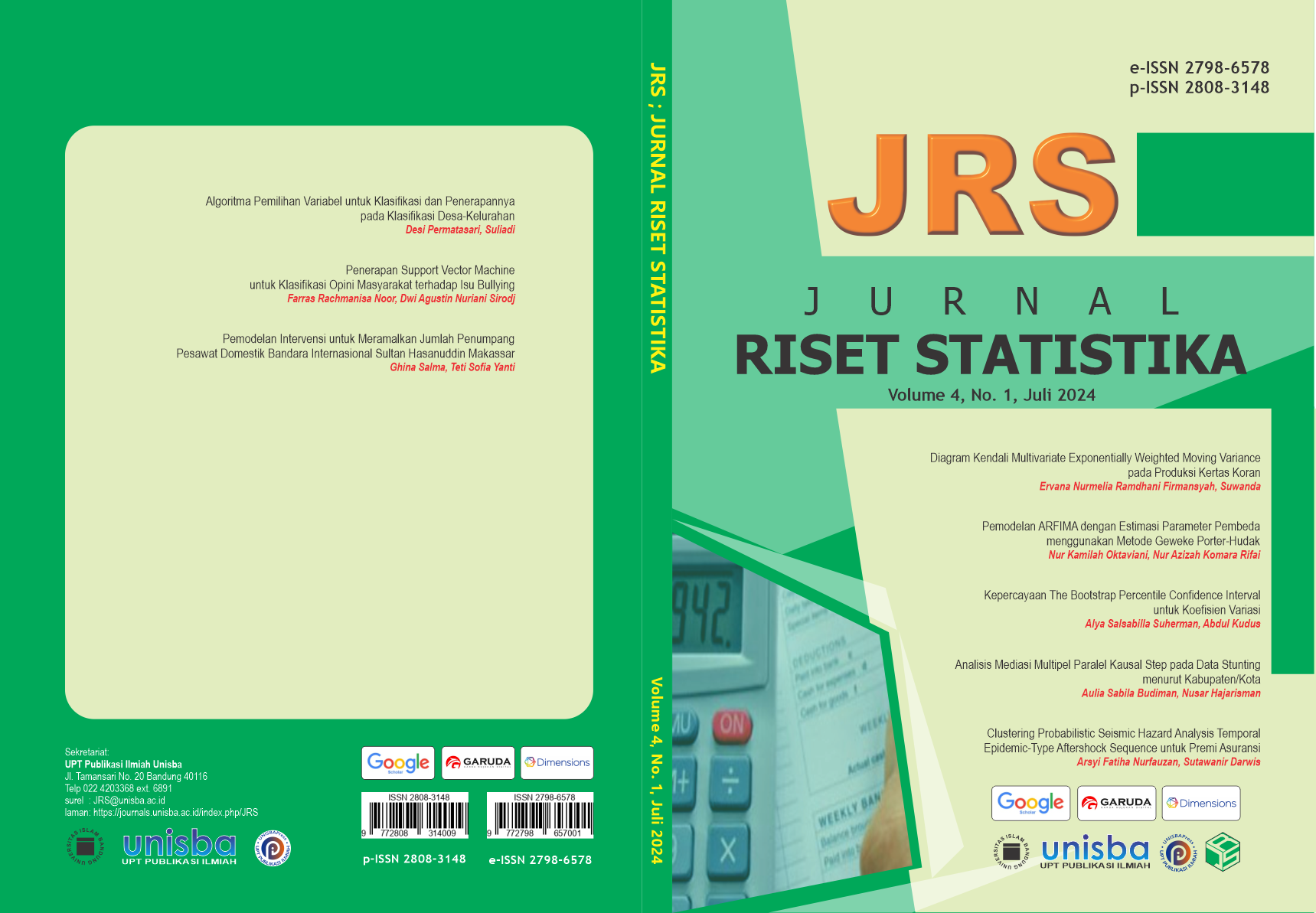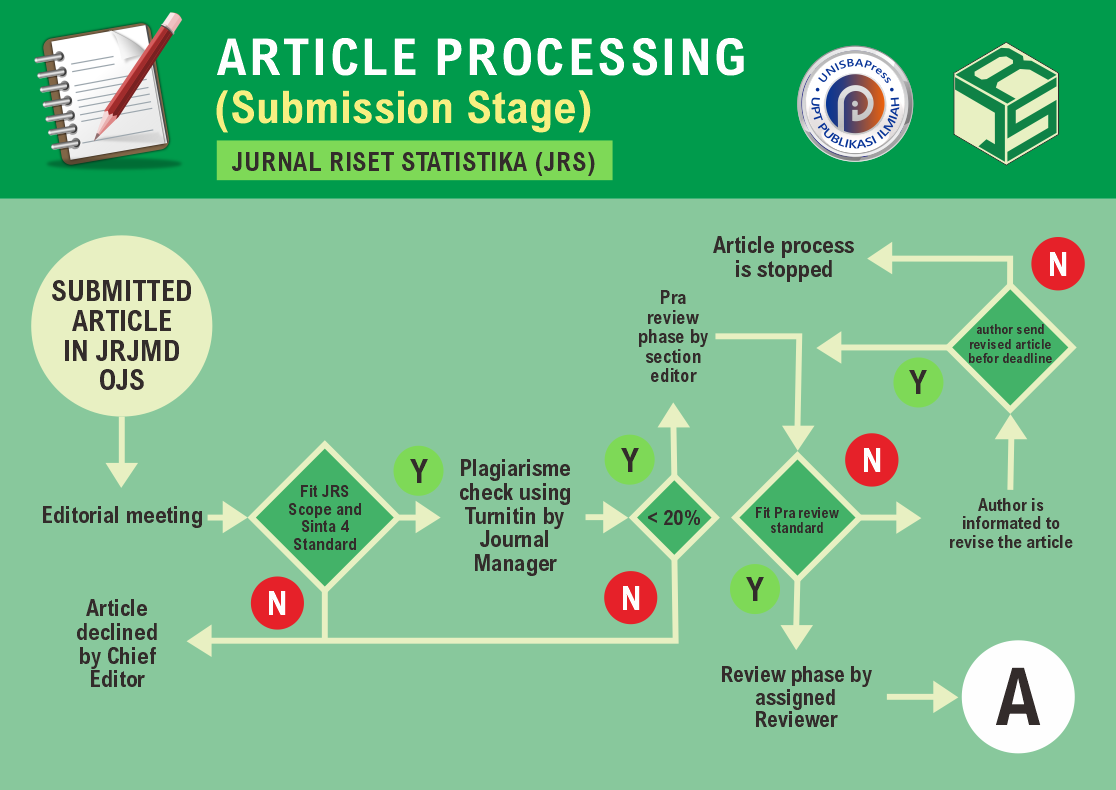Clustering Probabilistic Seismic Hazard Analysis Temporal Epidemic-Type Aftershock Sequence untuk Premi Asuransi
DOI:
https://doi.org/10.29313/jrs.v4i1.3864Keywords:
Asuransi Gempa Bumi, Clustering, Seismic Hazard ETASAbstract
Abstract. An earthquake is an event that releases energy in the earth's crustal rocks, which can trigger aftershocks. The economic losses caused by earthquakes can be mitigated through earthquake insurance. However, conventional premium calculations only take into account the main earthquake (mainshock), while aftershocks are excluded through a declustering process. This article presents the development of Clustering Probabilistic Seismic Hazard Analysis (CPSHA) to evaluate earthquake risk by incorporating aftershock effects using a temporal Epidemic-Type Aftershock Sequence (ETAS) model. The approach is an improvement on traditional earthquake insurance premium calculations, which generally only consider the main earthquake. The ETAS model, with parameters θ=(μ,K,c,α,p), is estimated through Maximum Likelihood Estimation (MLE). This analysis combines seismic hazard ETAS with structural damage data to determine the pure premium of earthquake insurance with aftershock. The study uses West Java earthquake data from 21 November 2022 to 18 February 2023, sourced from the BMKG catalogue. The results indicate that customers in the Cianjur area must pay a total insurance premium (TP) of Rp 28.263.945,00 per year for clusters. This approach enhances the comprehension of earthquake risk and can aid in the calculation of more precise insurance premiums.
Abstrak. Gempa bumi merupakan peristiwa pelepasan sejumlah energi pada batuan kerak bumi yang dapat memicu gempa susulan (aftershock). Dampak dari gempa bumi dapat menyebabkan kerugian ekonomi. Salah satu cara untuk menanggulangi hal tersebut dengan asuransi gempa bumi. Perhitungan premi konvensional hanya memperhitungkan gempa utama (mainshock) sementara aftershock disisihkan melalui proses declustering. Artikel ini menyajikan pengembangan Clustering Probabilistic Seismic Hazard Analysis (CPSHA) untuk mengevaluasi risiko gempa bumi dengan memasukkan efek aftershock menggunakan model Epidemic-Type Aftershock Sequence (ETAS) secara temporal. Perhitungan premi asuransi gempa bumi umumnya hanya mempertimbangkan gempa utama, namun pendekatan ini menyertakan aftershock dalam estimasi premi. Model ETAS dengan parameter θ=(μ,K,c,α,p) diestimasi melalui Maximum Likelihood Estimation (MLE). Analisis ini menggabungkan seismic hazard ETAS dengan data kerusakan struktur untuk menentukan premi murni asuransi gempa bumi dengan aftershock. Data yang digunakan adalah data gempa bumi Jawa Barat 21 November 2022 sampai 18 Februari 2023 melalui katalog BMKG. Hasil yang diperoleh menunjukkan total premi (TP) asuransi yang harus dibayarkan oleh nasabah untuk cluster di wilayah Cianjur sebesar Rp 28.263.946,00 per tahun. Pendekatan ini memberikan kontribusi pada pemahaman risiko gempa bumi dan dapat digunakan dalam perhitungan premi asuransi yang lebih akurat.
References
G. L. Yeo and C. A. Cornell, “A Probabilistic Framework for Quantification of Aftershock Ground‐Motion Hazard in California: Methodology and Parametric Study,” Earthq Eng Struct Dyn, vol. 38, no. 1, pp. 45–60, Jan. 2009, doi: 10.1002/eqe.840.
I. Iervolino, “Generalized Earthquake Counting Processes for Sequence‐Based Hazard,” Bulletin of the Seismological Society of America, vol. 109, no. 4, pp. 1435–1450, Aug. 2019, doi: 10.1785/0120180271.
S. Yaghmaei‐Sabegh, P. Shoaeifar, and N. Shoaeifar, “Probabilistic Seismic‐Hazard Analysis Including Earthquake Clusters,” Bulletin of the Seismological Society of America, vol. 107, no. 5, pp. 2367–2379, Oct. 2017, doi: 10.1785/0120170031.
Y. Ogata, “Estimation of The Parameters in The Modified Omori Formula for Aftershock Frequencies by The Maximum Likelihood Procedure,” Journal of Physics of the Earth, vol. 31, no. 2, pp. 115–124, 1983, doi: 10.4294/jpe1952.31.115.
R. Nurfitri and T. S. Yanti, “Pemodelan Umur Harapan Hidup di Jabar Tahun 2021 Menggunakan Spatial Durbin Model,” Jurnal Riset Statistika, vol. 3, no. 2, pp. 137–146, Dec. 2023, doi: 10.29313/jrs.v3i2.3023.
N. Suhartina and I. Sukarsih, “Model SVEIR Penyebaran Penyakit Rabies Terhadap Anjing dengan Vaksinasi,” DataMath: Journal of Statistics and Mathematics, vol. 2, no. 1, pp. 25–32, 2024.
H. M. Taylor and S. Karlin, An Introduction to Stochastic Modeling, 3rd Ed. Academic Press, 1998.
J. Baker, B. Bradley, and P. Stafford, Seismic Hazard and Risk Analysis. Cambridge University Press, 2021. doi: 10.1017/9781108425056.
A. Deniz, “Estimation of Earthquake Insurance Premium Rates Based Stochastic Methods,” Middle East Technical University, 2006.
D. Harte, “PtProcess: An R Package for Modelling Marked Point Processes Indexed by Time,” J Stat Softw, vol. 35, no. 8, 2010, doi: 10.18637/jss.v035.i08.













